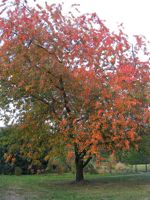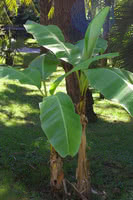Mon-Fri 9am - 5pm Mountain time
Black Cherry vs Hardy Banana
Prunus serotina
Musa basjoo
NOT AVAILABLE THIS SEASON - MIGHT RETURN
CUSTOM GROW
Black Cherry is common in eastern North America but a rare find elsewhere. This tree is shade tolerant and is often found in old fields, forest openings, and along fencerows.
The fruit is edible and is commonly used to flavor rum and brandy. It is also edible and often eaten fresh or used in wine or jelly. Black Cherry trees typically begin producing fruit when they are 10 years of age.
Black Cherry wood is a rich reddish-brown color and is strong, making it valued in cabinetry and woodworking. It is often used in reclamation as well.
The leaves can poison livestock as they contain cyanide derivatives and precursors. However, many have noted that deer still seem to browse their trees with impunity and birds and other animals eat the fruit when available.
The Hardy Banana is a fast-growing evergreen perennial that dies down to the ground each year. A stunning tropical-looking accent for your yard and patio, the Japanese Fiber Banana can be overwintered outdoors in several northern U.S. states and southern Canadian regions. In northern regions, you can bring this plant inside and leave it in your garage. If you enjoy Mexican cuisine, you can use the leaves to make tamales.
Black Cherry Quick Facts
Hardy Banana Quick Facts
Toxicity: bark and wilted leaves toxic to livestock

